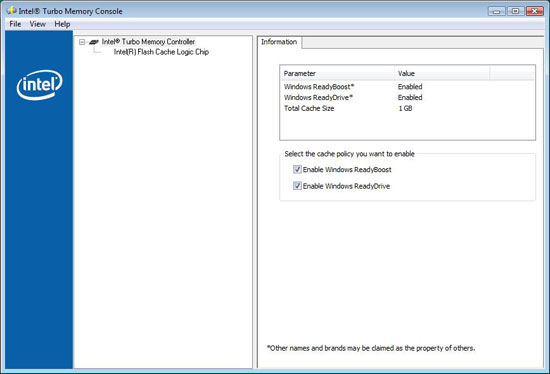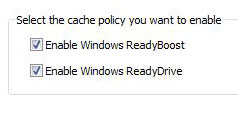Investigating Intel's Turbo Memory: Does it really work?
by Anand Lal Shimpi on June 19, 2007 3:39 PM EST- Posted in
- Laptops
Problem 1: A Poorly Written Control Panel
Intel's Turbo Memory requires a driver be installed in order to enable the technology, but the driver Intel provides is a bit finicky in operation. Installing the driver works like you would expect it to, you install the driver and Vista asks to be rebooted; when Vista comes back up is where the situation has to be handled differently.
Vista must be rebooted a second time in order for Turbo Memory to be completely enabled. Intel claims the second reboot is a Microsoft issue and Microsoft itself generally won't tell us about what Vista is doing under the hood so we're left in the dark here.
After the second reboot, you aren't in the clear yet. Vista needs several more reboots (with extended periods of idle time between reboots) to recognize that Turbo Memory is there and operational, and according to Intel, it needs to "learn" how to use the ReadyDrive cache. Once again, we'd love to explain the nuts and bolts of why this is necessary but sadly much of Vista remains a black box to us.

If you follow all the instructions, reboot enough times and please the NAND Flash Gods, Intel's Turbo Memory will be enabled. You'll even have a nice little control panel you can use to confirm that it is enabled, but here is where things can go wrong once more.
The control panel has two check boxes that appear to be used to "select the cache policy you want to enable":

We originally made the mistake of trusting what the console said; don't touch these boxes and you'll be fine
By no means should you check or uncheck either of these boxes. According to Intel, they are not meant to be used to enable/disable Turbo Memory, and tinkering with them may enable or disable the technology with no way of confirming what has happened. Intel went as far as to say that if we touched anything on this page that we shouldn't trust what the control panel told us because it may not be correct; the control panel should simply be used as a visual tool to confirm that ReadyBoost and ReadyDrive are enabled. The control panel will tell you the truth about whether or not the RB/RD caches are enabled, so long as you don't touch any of the buttons.
We rebooted as much as we needed to (7 times total including the reboot requested by the driver install), left the computer idle between each reboot for 10 minutes, and stayed far away from the tempting checkboxes in the Turbo Memory Console; after all of that, we had Turbo Memory enabled with 100% certainty and we could begin our testing.










31 Comments
View All Comments
Alyx - Thursday, June 21, 2007 - link
It seems readyboost only helps with subsequent reads rather than the initial read, so it makes no sense as to why it would help in the case of watching a movie because the data is never repeated. I guess it just keeps the drive from idling because its farther between reads.I think this would help a lot for students, when I sit in class for an hour or two taking notes I'm only using one program so theoretically it would never have to access the hard drive for the whole class time. If a student had classes back to back without a way to charge (which is often the case) this technology could make a noticeable difference.
BigLan - Thursday, June 21, 2007 - link
It could help with movies if it's used as a read-ahead cache. Once the OS sees that the movie file has been read, it loads the whole of the movie into flash (or as much as would fit.)Also, if you're working in class with just word (or onenote) open, your hard drive should be pretty inactive anyway. Once the program is loaded into ram then the drive isn't read from. If you have an autosave feature turned on then that would hit the HD, but having the file on an external flash drive would get around that anyway.
xanderman - Saturday, November 7, 2009 - link
I have a 4GB Turbo Memory card installed, $65.I think the article could use a little update to reflect on the availability of faster and larger Turbo Memory cards at lower prices, to examine their overall effectiveness in this (newer?) format and pricing.
I don't know if there was any performance boost, never did any benchmarks and all I've been doing is setting up this new computer, then install i-ram and continue customizations.
I can tell you, however, that the installation was easy, one reboot, so the article is definitely way off in regards to installation, OUTDATED and UNRELIABLE.
Glad I never beleived them n the first place and bought the card despite their opinion.
casket - Thursday, June 21, 2007 - link
"However, adding 1GB of actual RAM won't improve battery life at all, and in fact it should reduce it slightly."-- What are the power requirements of Flash vs. Ram vs. Hard Drive?
I would have liked to have seen Anand test the power benchmarks on the additional 1 GB ram as well.
burnley - Thursday, June 21, 2007 - link
Wouldn't it be cool if the manufacturers could load safe drivers on something like this so when your mum gets a virus and you have to reload everything you don't have to either hunt for the driver disk, or hunt for the drivers online, just access them from an internal read-only drive?On-board network is great unless you don't have the motherboard driver disk and a fresh boot, then that loverly external USB flash drive is a godsend.
strikeback03 - Thursday, June 21, 2007 - link
Isn't that the point of these "hidden" hard drive partitions that so many computers have these days?burnley - Thursday, June 21, 2007 - link
Unless the hard drive fails, or you want to upgrade it, etc. Also that is only applicable on pre-built machines.A simple flash device with drivers could be put on add-in cards like graphics, etc.
Only an idea...
xsilver - Thursday, June 21, 2007 - link
1gb of ram can be had for a lot less than $100
JarredWalton - Thursday, June 21, 2007 - link
ReadyBoost capable USB Flash sticks are available for something like $15 for 1GB, $24 for 2GB, or a whopping $40 for 4GB. Turbo Memory modules on the other hand are not merely a USB device that you plug in, so they currently cost more. Of course, there seems to be a healthy price premium for the technology right now....Adding a 1GB ReadyBoost device is cheap and easy. Adding 1GB of Turbo Memory seems pointless as it will cost more than 1GB of actual RAM. However, adding 1GB of actual RAM won't improve battery life at all, and in fact it should reduce it slightly. So, you're paying $100 for slightly improved performance along with potentially better battery life.
BigLan - Thursday, June 21, 2007 - link
It seems like an extra $100 for this stuff would be better spent on an extra battery for your laptop which would double the battery life (though you have to switch them out and recharge them.) You could probably also afford a 1 gig flash drive for readyboost.